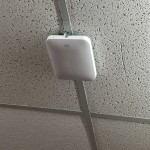Network Cabling Installation
Network cabling is used to connect computers, printers, servers, and other devices within an office together. The network cabling installation plays an important role in how the system will function after the cable is installed.
A few best practices to follow when performing a new network cabling installation are to: allow the cable to follow a gentle bend, no tight pulls around a corner, run a new line if needed-do not splice any data lines together, follow the manufactures guidelines when running new cable, once the line has been installed, test and certify to be sure it will work as intended to do.
A best practice is to run cabling in the rafters in the overhead part of the ceiling. Support will be provided by the rafters and this will keep the cabling out of the way from other trades. Install a pull string is another best practice when running new cabling. When you run new wire during a network cabling installation, add a pull string to the cable so the next time you will have something to use and make the job easier. Not every location has rafters, and it may require to have J Hooks to be installed into the walls to support the cable. If cabling is not supported, the wiring will start to separate inside where the twist are and will affect the data transmission. Using a system of J hooks, ladder racks, or other building material will provide the support needed for your telecommunications system.
Each location and system is different and it is important to review the location before running new lines. Survey the walls and plan where the cabling will be needed to be run. Avoid leaving a network cabling installation on top of florescent lighting, as they can cause interference to the data lines.
Network Cabling Installation

Network Cabling Installation
